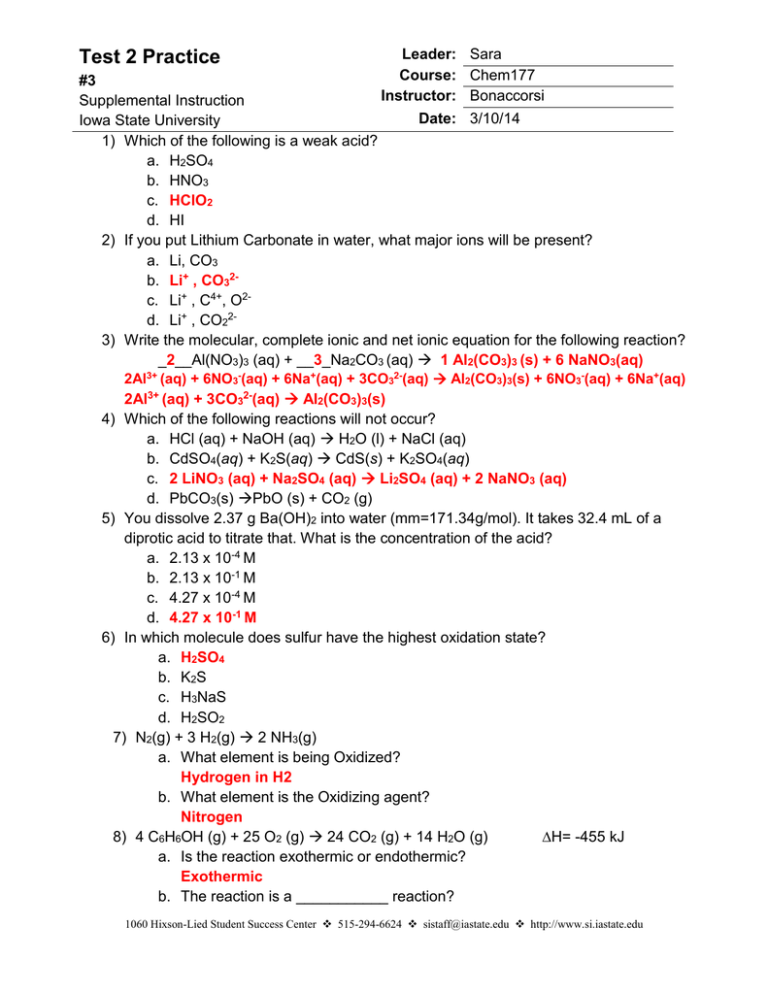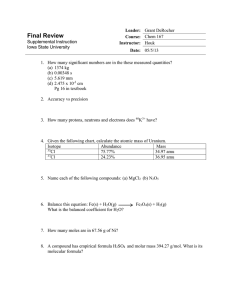Test practice 2C answers
advertisement

Test 2 Practice Leader: Sara Course: Chem177 Instructor: Bonaccorsi #3 Supplemental Instruction Date: 3/10/14 Iowa State University 1) Which of the following is a weak acid? a. H2SO4 b. HNO3 c. HClO2 d. HI 2) If you put Lithium Carbonate in water, what major ions will be present? a. Li, CO3 b. Li+ , CO32c. Li+ , C4+, O2d. Li+ , CO223) Write the molecular, complete ionic and net ionic equation for the following reaction? _2__Al(NO3)3 (aq) + __3_Na2CO3 (aq) 1 Al2(CO3)3 (s) + 6 NaNO3(aq) 3+ 2Al (aq) + 6NO3-(aq) + 6Na+(aq) + 3CO32-(aq) Al2(CO3)3(s) + 6NO3-(aq) + 6Na+(aq) 2Al3+ (aq) + 3CO32-(aq) Al2(CO3)3(s) 4) Which of the following reactions will not occur? a. HCl (aq) + NaOH (aq) H2O (l) + NaCl (aq) b. CdSO4(aq) + K2S(aq) CdS(s) + K2SO4(aq) c. 2 LiNO3 (aq) + Na2SO4 (aq) Li2SO4 (aq) + 2 NaNO3 (aq) d. PbCO3(s) PbO (s) + CO2 (g) 5) You dissolve 2.37 g Ba(OH)2 into water (mm=171.34g/mol). It takes 32.4 mL of a diprotic acid to titrate that. What is the concentration of the acid? a. 2.13 x 10-4 M b. 2.13 x 10-1 M c. 4.27 x 10-4 M d. 4.27 x 10-1 M 6) In which molecule does sulfur have the highest oxidation state? a. H2SO4 b. K2S c. H3NaS d. H2SO2 7) N2(g) + 3 H2(g) 2 NH3(g) a. What element is being Oxidized? Hydrogen in H2 b. What element is the Oxidizing agent? Nitrogen 8) 4 C6H6OH (g) + 25 O2 (g) 24 CO2 (g) + 14 H2O (g) ∆H= -455 kJ a. Is the reaction exothermic or endothermic? Exothermic b. The reaction is a ___________ reaction? 1060 Hixson-Lied Student Success Center 515-294-6624 sistaff@iastate.edu http://www.si.iastate.edu i. REDOX ii. Neutralization iii. Combination iv. None of the above c. What is the change in enthalpy given off when 63.4 g C6H6OH is burned (mm = 95 g/mol ) 63.4 g C6H6OH | 1 mol C6H6OH | -455 kJ | = 76 kJ | 95 g C6H6OH | 4 mol C6H6OH | 9) If 100. mL or .50 M HBr and 50.0 mL of 1.00 M NH4OH are mixed in a calorimeter, the temperature goes from 19.0ºC to 301K. You can assume the specific heat and density of the solution to be the same as water. What is the enthalpy change of the reaction: HBr (aq) + NH4OH (aq) H2O (l) + NH4Br (aq)? qsol = m cs ( Tf - Ti ) = (150. g) (4.184 J/gK) ((301K – 273K) – 19.0C) = 5650 J qrxn = -qsol = - 5650 J = -5.65 kJ .100 L HBr * .50 M HBr = .05 mol HBr .00500 L NH4OH * 1.00 M NH4OH = .05 mol NH4OH ****No limiting reagent****** -5.65 kJ is for .05 mol HBr and NH4OH ∆Hrxn = -5.65 kJ / .05 mol = -113 kJ 10) Using the given information: (C (s) + O2 (g) CO2 (g) (C3H8 (g) + 5O2 (g) 4H2O (l) + 3CO2 (g) (H2 (g) + 1/2 O2 (g) H2O (l) Find ΔH for the reaction: 3C (s) + 4H2 (g) C3H8 (g) ΔH = -394 kJ) * 3 ΔH = -2220 kJ) * -1 ΔH = -286 kJ) * 4 ΔH = -52 kJ ( 3 ) ( -394 ) + ( -1 ) ( -2220 ) + ( 4 ) ( -286 ) = -1128 + 2220 + -1144 = -52 kJ 11) Calculate the ∆Hrxn for the following equation? 3 PbBr2 (s) + 4 H2O (l) Pb3O4 (s) + 6 HBr (g) + H2 (g) [(0) + (6) (-36.2) + (1) (-734.7)] – [(3) (-277.0) + (4) (-285.8)] Molecule HBr (g) H2O (g) H2O (l) PbBr2 (s) Pb3O4 (s) 12) Which subshell containes 3 orbitals? a. 4s b. 6f c. 3p ∆Hfº (kJ/mol) -36.2 241.8 -285.8 -277.0 -734.7 d. 3d e. 4d 13) If your microwave radiates waves with a wavelength of .34 dm, what is the energy of those waves? 5.9 x 10-24 J 14) Which transition of an electron requires the most energy to take place? a. n=3 n=4 b. n=6 n=2 c. n=1 n=5 d. n=4 n=1 15) For which element is the ground state electron configuration: [Kr]5s14d5? Mo






